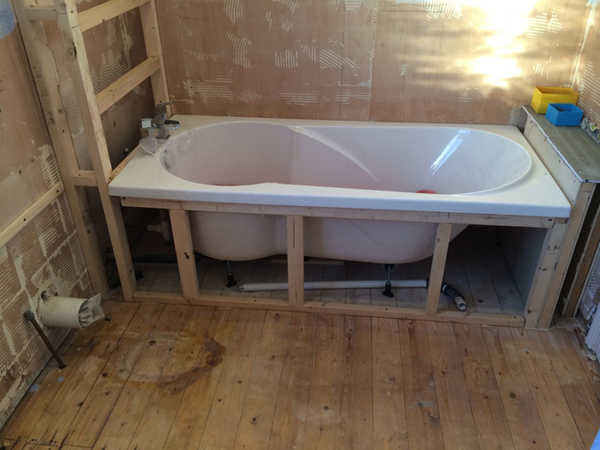What're your thoughts about A Step-by-Step Guide to Installing a Bathtub?

Setting up a bath tub isn't exactly brain surgery, however it does call for solid plumbing, carpentry, as well as occasionally, tiling skills. Replacing an old bath tub with a new one is also a reasonably hard job. If the old bathtub is conveniently available, the job can relocate easily; if you need to open up a wall to remove the old bathtub and also place the new bathtub, the task is a lot harder. In either situation, the job is within a residence handyman's abilities, although you will need a helper to leave the old bathtub and also embeded in the new one. Make certain you have actually certified on your own for the task and also fit trying it. As opposed to hiring a professional to take control of a halfway-completed job, it is far better to take into consideration employing one before you begin. Possibilities are you might require a specialist plumber to make tube links.
This article will help you install a new bathtub in your restroom if you have already purchased a new tub and don't need to change the arrangement of your previous water supply pipes.
Your tools and material list need to make up the following:
Removing Old Touches
If you require to replace old faucets with new ones as a part of your setup, then the first thing you ought to do is disconnect the supply of water. After doing so, turn on the taps to drain any kind of water continuing to be in the system. The procedure of getting rid of the existing faucets can be rather problematic due to the limited accessibility that is commonly the instance.
Utilize a basin wrench (crowsfoot spanner) or a faucet device to undo the nut that connects the supply pipes to the faucets. Have a fabric prepared for the staying water that will come from the pipelines. As soon as the supply pipes have been gotten rid of, utilize the same device to loosen the nut that holds the taps onto the bath/basin. You will certainly need to stop the solitary taps from turning throughout this process. Once the faucets have been removed, the holes in the bath/basin will certainly have to be cleansed of any old securing compound.
Before going on to fit the new taps, compare the pipe links on the old faucets to the brand-new taps. If the old taps are longer than the new taps, after that a shank adapter is needed for the brand-new faucets to fit.
Fitting New Touches
If the tails of the brand-new faucets are plastic, after that you will need a plastic connector to stop damage to the string. One end of the connector fits on the plastic tail of the faucet and also the various other end offers a connection to the current supply pipelines.
If you need to fit a monobloc, then you will call for decreasing couplers, which connects the 10mm pipeline of the monobloc to the typical 15mm supply pipeline.
Next, position the faucet in the mounting opening in the bath/basin making sure that the washing machines are in place in between the faucet and the sink. Secure the faucet in position with the producer given backnut. As soon as the tap is securely in position, the supply pipes can be connected to the tails of the faucets. The faucets can either be connected by utilizing corrugated copper piping or with normal faucet connectors. The previous kind ought to be connected to the faucet ends initially, tightening up only by hand. The supply pipelines can later on be connected to the various other end. Tighten both ends with a spanner after both ends have been attached.
Installing the Bathtub
Making use of the two wood boards under its feet, put the bathtub in the called for setting. The wooden boards are valuable in evenly spreading out the weight of the tub over the area of the boards rather than concentrating all the weight onto 4 tiny points.
The next goal is to make sure that the bathtub is leveled all round. This can be accomplished by checking the level and adjusting the feet on the bath tub up until the level reviews degree.
To install faucets, fit the bottom of the outermost flexible faucet connector to the proper supply pipeline by making a compression join; after that do the same for the various other tap.
Activate the water supply as well as examine all joints as well as brand-new pipework for leaks and also tighten them if required. Load the bathtub and also examine the overflow outlet as well as the regular electrical outlet for leaks.
Lastly, deal with the bath paneling as explained in the supplier's instruction manual. Tiling as well as securing around the bathtub ought to wait till the bath tub has been utilized at the very least once as this will resolve it into its final placement.
Getting ready for the Installment
Firstly, the supporting framework provided with the bath ought to be fitted (if called for) according to the maker's guidelines. Next, fit the taps or mixer to the tub. When suitable the faucet block, it is important to ensure that if the tap features a plastic washing machine, it is fitted between the bath and the taps. On a plastic bathroom, it is additionally reasonable to fit a supporting plate under the taps system to avoid stress on the bath tub.
Fit the adaptable faucet adapters to the bottom of the two taps using 2 nuts and olives (often supplied with the tub). Fit the plug-hole outlet by smearing mastic filler round the sink outlet hole, and after that pass the outlet with the hole in the bathroom. Utilize the nut provided by the maker to fit the plug-hole. Check out the plug-hole electrical outlet for an inlet on the side for the overflow pipeline.
Next, fit the end of the versatile overflow pipe to the overflow outlet. After that, screw the pipe to the overflow face which ought to be fitted inside the bath. Make sure you use all of the provided washing machines.
Attach the catch to the bottom of the waste electrical outlet on the bath tub by winding the string of the waste electrical outlet with silicone mastic or PTFE tape, as well as screw on the catch to the outlet. Connect the bottom of the overflow tube in a similar manner.The bath should now be ready to be suited its last placement.
Tiling Around the Tub
In the area where the bath meets the tile, it is essential to secure the joins with a silicone rubber caulking. This is essential as the fitting can move enough to fracture a rigid seal, triggering the water to permeate the wall between the bathroom and also the tiling, causing issues with dampness and feasible leakages to the ceiling below.
You can pick from a selection of coloured sealants to blend in your components as well as fittings. They are sold in tubes and also cartridges, as well as are capable of sealing voids approximately a size of 3mm (1/8 inch). If you have a larger space to fill, you can load it with twists of drenched paper or soft rope. Keep in mind to always fill up the bathtub with water prior to securing, to enable the movement experienced when the bathtub is in use. The sealer can split fairly very early if you do not take into consideration this motion before securing.
Alternatively, ceramic coving or quadrant floor tiles can be utilized to edge the bathroom or shower tray. Plastic strips of coving, which are easy to use as well as cut to dimension, are additionally quickly available on the market. It is suggested to fit the ceramic tiles using waterproof or water resistant glue as well as cement.
How to Install or Replace a Bathtub
Find Your Dimensions
The first step in any bathtub installation or replacement is to select the right size tub for your bathroom. Start by measuring your existing bathtub’s alcove from wall to wall. The standard size for bathtubs is around 5 feet long and 30 or 32 inches wide. Purchase the size that’s closest to your previous tub.
After you’ve measured, you’ll need to figure out what type of tub you need. Face the alcove. If the drain is on the right-hand side, you’ll need a right drain tub. If it’s on the left, get a left drain tub. Easy enough, right?
Disconnect the Water Supply and Drain Assembly
Before you can start on your removal, make sure that you turn off the tub’s water supply. Some bathrooms have a shutoff valve, but if you don’t see one, you’ll need to turn off the supply at your house’s water main. Once the water’s off, open the valves to release any remaining air in the supply lines.
Then, disconnect the tub drain flange. This process varies based on the type of drain you have, but in most cases, you’ll need a drain flange removal tool to perform this task. If you’re feeling handy, you might be able to use a pair of needle-nose pliers to twist and pull the flange.
Now comes the fun part. In order to disconnect the drain assembly, you’ll need to be able to get to the space underneath the tub. You might need to access the tub drain from a crawlspace or a basement. Don’t forget to take a pipe wrench with you, as you’ll need it to loosen the pipe at the connection.
Cut Out the Old Tub
After removing the drainpipe assembly, you can take out the old bathtub. Cut a strip above the tub edge in the wall surrounding the bathtub that's about 6 inches in height. The tools you need here may vary depending on the type of wall surround you have in the alcove. If you’re cutting drywall, use a drywall saw and remove the section of the wall all the way down to the studs. If you have tile, you’ll need to use a grinder with a diamond blade to cut through the grout line. Then, use a chisel to remove the individual tiles. Take care here not to cut through any studs.
Find the tub flange. Remove the screws that attach the flange to the studs in the wall. At this point, the tub should be freed from the wall.
Once you’ve removed the flange, use a utility knife to cut away the caulk between the tub and the floor. When this is done, you should be able to lift the tub up and out of the alcove. Keep in mind that, depending on what it’s made of, the old tub could be tremendously heavy. You should plan to have a friend help you move it just in case.
Install the New Tub
Before you make any adjustments to the area, place the new tub in the alcove to make sure it fits properly and that the tub drain lines up with the P-trap underneath the floor.
Remove it and install a 2 x 4 ledger board. Measure the tub’s flange, then mark that height on the wall. Screw the ledger board to studs in the wall. This will help to support the weight of the tub.
Once the ledger board has been installed, go ahead and secure the drain to the tub. For this step, you’ll need some plumber’s putty. Roll a small amount of putty in your hands and wrap it around the underside of the drain flange. Push the drain into the tub from underneath the tub.
When the drain has been attached, connect the overflow drain. To do this, you’ll place the gasket on the overflow elbow and move it behind the tub. Once that’s on, connect the overflow pipe and the drainpipe, but take care not to overtighten.
Secure the Tub
After the connections are in, it’s time to set the tub in place. Before you start, make sure the flange lines up with the markings you made in Step 4. Because the ledger board holds the tub in place, it’s important that it matches up. If not, you’ll need to remove it and readjust.
Once your measurements line up, attach the flange to the studs on all three sides of the wall. Please note that you should not screw the flange to the wall. Instead, you should use roofing nails because they won’t rust over time. When the tub is in place, install the baseboard and the molding in front of and around the tub.
Repair and finish off the drywall or tile that you cut in Step 3. If you’re installing a fiberglass bath surround, now’s the time to adhere it to the alcove.
Then, enjoy your tub! While all these steps might seem intimidating, removing and installing a new bathtub is a relatively easy DIY project that can be completed in a single day. And now, when you settle in for your next bubbly soak, you can enjoy your bath without the distraction of a tub in disrepair.
https://www.homeserve.com/en-us/blog/how-to/bathtub-replacement/
I'm just very involved in A Step-by-Step Guide to Installing a Bathtub and I really hope you enjoyed my piece. In case you liked our blog entry please be sure to pass it around. Thank you so much for going through it.
This Website
 Hallie Eisenberg Then & Now!
Hallie Eisenberg Then & Now! Seth Green Then & Now!
Seth Green Then & Now! Talia Balsam Then & Now!
Talia Balsam Then & Now! Richard Dean Anderson Then & Now!
Richard Dean Anderson Then & Now! Mike Smith Then & Now!
Mike Smith Then & Now!